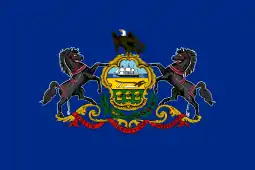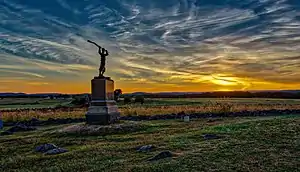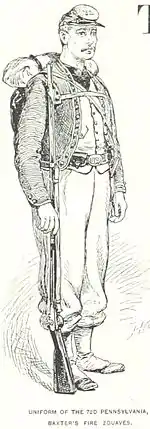72nd Pennsylvania Infantry Regiment
The 72nd Pennsylvania Infantry (originally raised as the 3rd California) was a volunteer infantry regiment which served in the Union Army during the American Civil War. It was part of the famous Philadelphia Brigade. They wore a very Americanized zouave uniform, consisting of a zouave jacket trimmed with red without a tombeux on the jacket, sky-blue trousers with a red stripe down the leg, a sky-blue zouave vest trimmed in red, white gaiters, and a dark blue kepi. The jacket was decorated with 16 ball brass buttons down the front of the jacket, which were not part of the original French Zouave uniform.
| 72nd Pennsylvania Volunteer Infantry | |
|---|---|
 Pennsylvania flag | |
| Active | August 1861 to June 24, 1864 |
| Country | United States |
| Allegiance | Union |
| Branch | Infantry |
| Engagements | Battle of Ball's Bluff Battle of Savage's Station Battle of Malvern Hill Battle of South Mountain Battle of Antietam Battle of Gettysburg Overland Campaign |

History
Colonel Edward D. Baker, powerful congressman and close friend of President Lincoln, organized the Third California Volunteer Infantry Regiment in Philadelphia, one of four regiments of the California Brigade. Baker wanted the brigade to represent and give credit to California in the Federal army. The regiment was recruited from among the firemen of Philadelphia, Pennsylvania in early August 1861. DeWitt Clinton Baxter was its colonel, Theodore Hesser lieutenant colonel, and J. M. De Witt major.[1]

After Baker's death October 21, 1861 at the Battle of Ball's Bluff, Pennsylvania reclaimed the regiments as its own. The California Brigade became the Philadelphia Brigade and each unit was given a new number. The Third California Regiment became the 72nd Pennsylvania Regiment. After some months of patrolling along the Potomac River, the 72nd was transported to the Peninsula. It saw its first action at the Battle of Seven Pines on May 1, 1862. During the Seven Days Battles, it supported the army's rear guard.
The 72nd saw light skirmishing at the Battle of Chantilly. At the Battle of Antietam, the regiment participated in the attack on the West Woods, being routed along with much of the rest of the division. Nearly half of the regiment was lost, including several officers killed.
At the Battle of Gettysburg, it defended the Angle on July 2 and 3. On the evening of the 2nd, it helped defeat Confederate Brigade General Ambrose R. Wright's attack, advancing just over the stone wall. The next day, it was placed in reserve for the brigade near the copse of trees. During Pickett's Charge, its position served as a rallying point for the left wing of the 71st and two companies of the 106th Pennsylvania, which had been driven back. Despite Brigadier General Alexander S. Webb's best efforts, these troops refused to counterattack for several minutes. This might have been due to the 71st's colorbearers being shot down. (Civil War regiments often followed the regimental flag since orders would have been difficult to hear on the battlefield.) At Gettysburg, Col. Baxter replaced the wounded General Webb in command of the Brigade, and Lt. Col. Hesser replaced him in command of the 72nd Regiment.
The unit fought well during the Overland Campaign and in the beginning stages of the Siege of Petersburg. On June 24, 1864, the regiment was mustered out of service.
A total of 1,600 men fought in the 72nd, of whom 1,053 became casualties, a 65% casualty rate.
Casualties during the war[1]
- Killed and mortally wounded: 12 officers, 198 enlisted men
- Wounded: 25 officer, 533 enlisted men
- Died of disease: 1 officers, 119 enlisted men
- Captured or missing: 2 officers, 163 men
- Total casualties: 40 officers, 1,014 enlisted men
Notes
- Dyer (1908), p. 1597.
References
- Dyer, Frederick H (1908). A Compendium of the War of the Rebellion. Des Moines, IA: Dyer Pub. Co. ASIN B01BUFJ76Q.
- Kennedy, Elijah (1912). The Contest for California in 1861: How Colonel E.D. Baker Saved the Pacific States for the Union. New York: Houghton Mifflin.
- Subcommittee on Veterans' Affairs, United States. Congress. Senate. Committee on Labor and Public Welfare (1968). Edward M Kennedy, Chairman (ed.). Medal of Honor, 1863-1968 : "In the Name of the Congress of the United States". Committee print (United States. Congress), 90th Congress, 2nd session. Washington DC: U.S. Government Printing Office. p. 1087. OCLC 1049691780.
- U.S. War Department (1880). The War of the Rebellion: A Compilation of the Official Records of the Union and Confederate Armies. Washington, DC: U.S. Government Printing Office. OCLC 857196196.
- "Hall of Valor: The Military Medals Database". The Hall of Valor Project. Sightline Media Group. 2020. Retrieved 19 May 2020.
- "MOHs - victoriacross". THE COMPREHENSIVE GUIDE TO THE VICTORIA & GEORGE CROSS. VCOnline. 2020. Retrieved 2 May 2020.
- "CMOHS.org - Official Website of the Congressional Medal of Honor Society". Congressional Medal of Honor Society. CMOHS. 2014. Retrieved 19 August 2014.
- "Home - The National Medal of Honor Museum The National Medal of Honor Museum". The National Medal of Honor Museum. The National Medal of Honor Museum Foundation. 2020. Retrieved 19 May 2020.
External links
- Pennsylvania in the Civil War
- California Military History Museum
- An address delivered at Gettysburg, August 27, 1883 (1883) at the Internet Archive
- Reply of the Philadelphia Brigade Association to the foolish and absurd narrative of Lieutenant Frank A. Haskell: which appears to be endorsed by the Military Order of the Loyal Legion Commandry of Massachusetts and the Wisconsin History Commission (1910) at the Internet Archive